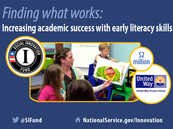 Since the Social Innovation Fund was created in 2009, grantees, partners, and nonprofit organizations working at the national and local level have made an impact on the lives of more than 400,000 Americans. In just five years, the Social Innovation Fund has proved to be more than just a funding source but a catalyst for impact changing the way the government serves the public. Get to know the Social Innovation Fund’s new Director, Damian Thorman, through the short Q&A below.
|
Why did you agree to
lead the Social Innovation Fund?
In my work over the last 25
years, and now at the Social Innovation Fund, I have been committed to
multi-sector, reciprocal relationships, with a consistent emphasis on an
exchange between sectors and leaders. The SIF is, in many ways, ideally suited
to deepen and advance these exchanges. Our combination of grantmaking programs
rooted in public-private partnerships allows us to facilitate an exchange of
ideas, a sharing and scaling of effective solutions, and the presentation of
evidence-based interventions that are working for low-income communities across
America.
This kind of layered
approach, both funder-to-funder and funder-to-community is central to my
mission. I hope that my work with the SIF will serve as an example for
ongoing work between the philanthropic and government sectors and with other
strategic sector leaders.
What experience do you bring to the SIF?
My career spans many different areas from media to policy to
nonprofit management. I was the policy and political director for Congressman
Richardson of New Mexico and served as a Professional Staff member of the U.S.
House Education and Labor Committee, where I led the committee’s passage of the
landmark Child Care Development Block Grant. As the Deputy Director of
the Academy of Pediatrics, I led the strategy to pass universal access to
health care in the 1990s, which resulted in the SCHIP program.
I also helped the Kauffman Foundation move from an operating
foundation to a foundation focused on strategic grantmaking and worked with the
the John S. and James L. Knight Foundation to increase citizen’s engagement in
civic life. Most recently, I started my own company, True North Philanthropic
Advisors to facilitate foundations, government and nonprofits working
collaboratively to increase programmatic impact.
What are your priorities for the Social Innovation Fund?
My
primary focus is to be the principal advocate for the SIF to Congress, media
and the public. It is also a primary focus of mine to ensure that the SIF is
providing the highest quality support possible to our grantees. I want to
significantly expand our capacity to tell the story of the people and families
we are impacting and to help build the capacity of our grantees to scale their
programs after SIF dollars end.
The Social Innovation Fund is committed to finding and advancing what works. Through an open and highly rigorous grant competition conducted over the past several months, the Social Innovation Fund has selected eight grantmaking organizations to participate in its SIF Classic Program. Since late July, the 2015 SIF Classic cohort has been sharing the great news with government officials, funders, and key partners involved in their SIF project.
Learn more about the six grantees who have announced thus far:
|
|
AARP Foundation's $3 million grant award will help grow student reading success by matching volunteers aged 50+ with children in K-3rd grade, who are reading below grade level. |
Local Initiatives Support Corporation was awarded $11 million to expand Bridges to Career Opportunities that offers job training and financial coaching to individuals struggling to find employment.
Wendy Spencer, CEO of the Corporation for National and Community Service, and Damian Thorman, director of the Social Innovation Fund, joined the Mayor’s Fund to Advance New York City at a press conference to announce a $6 million grant award that will enhance access to mental health services for at-risk New Yorkers through the Connections to Care initiative.
Nebraska Children and Families Foundation was awarded $2 million to expand Connected Youth Communities across rural Nebraska for young people with experience in the foster care and juvenile justice systems, struggling with homelessness, or who are disconnected from a family structure.
REDF was awarded $7 million to expand social enterprise solutions that will create jobs for individuals with multiple barriers to employment, including dislocated youth, formerly homeless or incarcerated individuals, and those
with severe mental illnesses. Learn more, here.
United Way of Lane County will leverage a $2 million grant to implement the evidence-based Kids in Transition to Schools (KITS) program to ensure children entering kindergarten are prepared both socially and academically. |
|
 |
 As students across the country
prepare to return to school after the summer break, the Social Innovation Fund
(SIF) is putting the Spotlight On its grantees that are
focused on increasing educational opportunities, readiness, and academic
achievement for today’s youth.
|
-
The Silicon Valley Community Foundation (SVCF) program, The Big
Lift, is implementing an approach to improving educational outcomes for youth
that includes four components: preschool, family engagement, summer learning,
and absenteeism reduction. “Our innovation is looking at four distinct,
evidence-based interventions and seeking to implement them all together,” said
Avo Makdessian, director of the SCVF Center for Early Learning. Learn more about this strategy to help
early learners reach the third grade benchmark for reading.
-
The quality of nurturing and care that children receive during
infancy and early childhood has profound and lifelong impacts on their health,
development, well-being, and self-sufficiency. The Institute for Child Success (ICS) is exploring how to best
ensure children from low-income communities have the supports they need for a
strong start in life. ICS is working with four jurisdictions, each of which is
focusing on a specific early childhood programming priority and implementing
established and/or evidence-based early-intervention and early-education
models. Learn more about
how this strategy is helping to create models of success.
-
Greater Twin Cities United Way (GTCUW) recognizes that while schools share accountability for
children’s education, every child needs broader community support as well.
Working with its partners through a local collective impact initiative, GTCUW
is aligning strategies and resources around five “cradle to career” goals that promote equal opportunities for all students in
the Minneapolis and Saint Paul areas. Learn
more about this
strategy designed to shrink the achievement gap, while improving grades and
social skills.
Remember to be on the lookout for next month’s feature when
we will put the spotlight on programs that are celebrating one year with the
Social Innovation Fund. Find out what they have been able to accomplish during
the past year and their plans for the future.
|